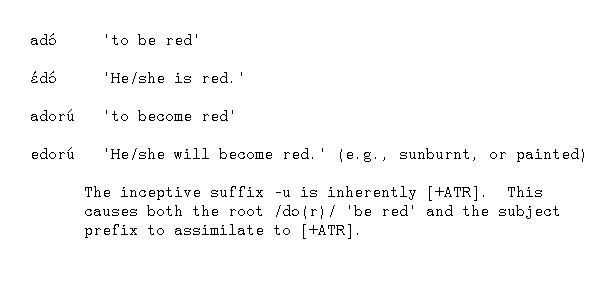|
|
|
|
 |
|
 |
Maa (or Maasai) has nine distinct vowels. (For some comparison, Swahili and Spanish have only five, while English arguably has thirteen.) The Maa vowels divide into two HARMONIZING SETS, depending on whether the TONGUE ROOT is moved forward (enlarging the throat cavity); or is in a neutral position or moved backwards (reducing the throat cavity). For some languages, linguists have proposed that it may be a downward movement of the larynx that creates the larger pharyngeal cavity. But whether it is a movement of the tongue root or a movement of the larynx, the significant feature is enlargement of the pharyngeal cavity.
The size of the throat cavity affects the acoustic sound waves that travel through the air, making the sounds distinct as they are first perceived by the hearer's ear, and then interpreted by the brain. There is simply nothing like this distinction in Swahili or Indo-European languages, and it requires considerable practice for someone whose first language does not have such sound contrasts to reliably recognize, and produce, the difference.
When the tongue root is moved forward, this is referred to as ADVANCED TONGUE ROOT (+ATR or "close"). When the tongue root is in the neutral or retracted position, the sound is referred to as Non-advanced or Retracted Tongue Root (-ATR or "open").
Many Maa words differ from each other
just by a change in the ATR value of a vowel. Thus, it is important to
represent all nine vowels, which we do here with the following symbols.
|
|
|
|
 |
|
 |
With these nine symbols, the fact that the following words
sound different can be represented. To hear how the vowels sound, just
click on any of the words.
|
|
|
 |
 |
 |
 |
|
|
ɛ |
 |
 |
 |
|
|
|
ɔ
|
 |
 |
 |
 |
|
|
ʊ
|
 |
|
 |
The two sets of vowels participate in a
VOWEL HARMONY system. Vowels in a given word
tend to be all [+ATR], or all [-ATR] (except that /a/ is neutral and occurs
with either set). The [+ATR] feature is
dominant, meaning
that if a morpheme which inherently has [+ATR] vowels is combined with
a morpheme which does not, all the vowels will assimilate to become [+ATR].
Interestingly, /a/ can "block" spreading of the ATR feature, so that
part of a word will be [+ATR], and part will be [-ATR]. (Note that
the basis for vowel harmony in Nilo-Saharan languages is different from
that in Altaic languages.)
 |
Back to top
Back
to The Maasai Language